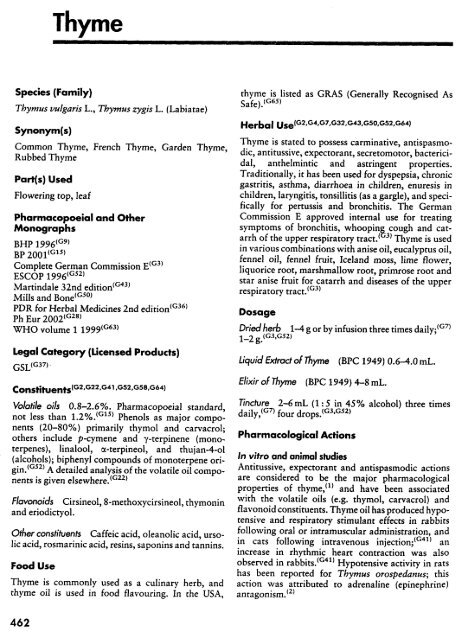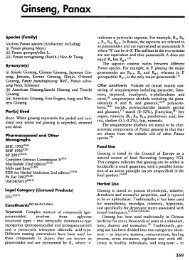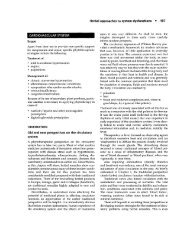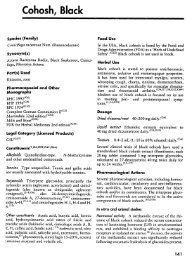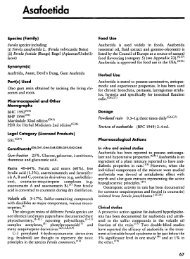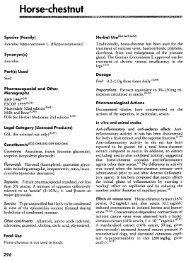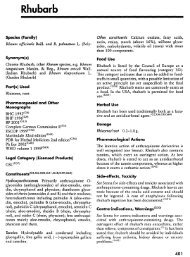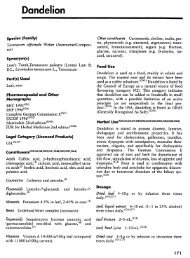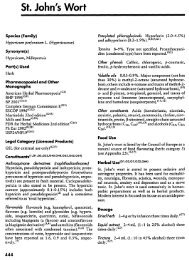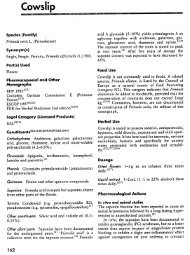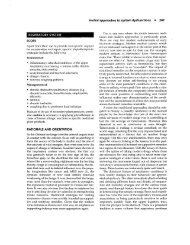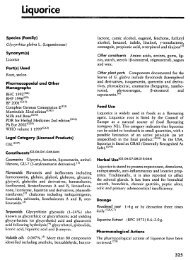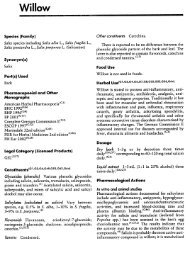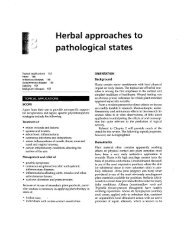Thymus vulgaris L., Thymus zygis L. (Labiatae) Common Thyme ...
Thymus vulgaris L., Thymus zygis L. (Labiatae) Common Thyme ...
Thymus vulgaris L., Thymus zygis L. (Labiatae) Common Thyme ...
Create successful ePaper yourself
Turn your PDF publications into a flip-book with our unique Google optimized e-Paper software.
<strong>Thyme</strong><br />
Species (Family)<br />
<strong>Thymus</strong> <strong>vulgaris</strong> L ., <strong>Thymus</strong> <strong>zygis</strong> L . (<strong>Labiatae</strong>)<br />
Synonym(s)<br />
<strong>Common</strong> <strong>Thyme</strong>, French <strong>Thyme</strong>, Garden <strong>Thyme</strong>,<br />
Rubbed <strong>Thyme</strong><br />
Part(s) Used<br />
Flowering top, leaf<br />
Pharmacopoeial and Other<br />
Monographs<br />
BHP 1996 (G9)<br />
BP 200 1(015)<br />
Complete German Commission E (G3)<br />
ESCOP 1996 (G52)<br />
Martindale 32nd edition (G43)<br />
Mills and Bone (GSO)<br />
PDR for Herbal Medicines 2nd edition (036)<br />
Ph Eur 2002 (G28)<br />
WHO volume 1 1999 (G63)<br />
Legal Category (Licensed Products)<br />
GSL (G37)<br />
Constituents (G2,G22,G41,G52,G58,G64)<br />
Volatile oils 0 .8-2 .6% . Pharmacopoeial standard,<br />
not less than 1 .2% . (015) Phenols as major components<br />
(20-80%) primarily thymol and carvacrol ;<br />
others include p-cymene and y-terpinene (monoterpenes),<br />
linalool, a-terpineol, and thujan-4-ol<br />
(alcohols) ; biphenyl compounds of monoterpene origin<br />
. (G52) A detailed analysis of the volatile oil components<br />
is given elsewhere<br />
(G22)<br />
.<br />
Flavonoids Cirsineol, 8-methoxycirsineol, thymonin<br />
and eriodictyol .<br />
Other constituents Caffeic acid, oleanolic acid, ursolic<br />
acid, rosmarinic acid, resins, saponins and tannins .<br />
Food Use<br />
<strong>Thyme</strong> is commonly used as a culinary herb, and<br />
thyme oil is used in food flavouring . In the USA,<br />
thyme is listed as GRAS (Generally Recognised As<br />
Safe ) . ( G65)<br />
Herbal Use (G2,G4,G7,G32,G43,G50,G52,G64)<br />
<strong>Thyme</strong> is stated to possess carminative, antispasmodic,<br />
antitussive, expectorant, secretomotor, bactericidal,<br />
anthelmintic and astringent properties .<br />
Traditionally, it has been used for dyspepsia, chronic<br />
gastritis, asthma, diarrhoea in children, enuresis in<br />
children, laryngitis, tonsillitis (as a gargle), and specifically<br />
for pertussis and bronchitis . The German<br />
Commission E approved internal use for treating<br />
symptoms of bronchitis, whooping cough and catarrh<br />
of the upper respiratory tract . () <strong>Thyme</strong> is used<br />
in various combinations with anise oil, eucalyptus oil,<br />
fennel oil, fennel fruit, Iceland moss, lime flower,<br />
liquorice root, marshmallow root, primrose root and<br />
star anise fruit for catarrh and diseases of the upper<br />
respiratory tract . (W)<br />
Dosage<br />
Dried herb 1-4g or by infusion three times daily ; (G7)<br />
1-2 g . (G3,G52)<br />
Liquid Extract of <strong>Thyme</strong> (BPC 1949) 0 .6-4 .0 mL .<br />
Elixir of <strong>Thyme</strong> (BPC 1949) 4-8 mL .<br />
Tincture 2-6mL (1 :5 in 45% alcohol) three times<br />
daily, (G7) four drops . (G3,GS2)<br />
Pharmacological Actions<br />
In vitro and animal studies<br />
Antitussive, expectorant and antispasmodic actions<br />
are considered to be the major pharmacological<br />
properties of thyme, (1) and have been associated<br />
with the volatile oils (e .g . thymol, carvacrol) and<br />
flavonoid constituents . <strong>Thyme</strong> oil has produced hyporensive<br />
and respiratory stimulant effects in rabbits<br />
following oral or intramuscular administration, and<br />
in cats following intravenous injection ; (G41) an<br />
increase in rhythmic heart contraction was also<br />
observed in rabbits . (G41 ) Hypotensive activity in rats<br />
has been reported for <strong>Thymus</strong> orospedanus ; this<br />
action was attributed to adrenaline (epinephrine)<br />
anragonism . (2)<br />
462
<strong>Thyme</strong> 463<br />
In vitro antispasmodic activity of thyme and<br />
related <strong>Thymus</strong> species has been asociated with the<br />
phenolic components of the volatile oil(3) and with the<br />
flavonoid constituents ; their mode of action is thought<br />
to involve calcium-channel blockage .( 1,4,5) The flavonoids<br />
thymonin, circilineol and 8-methoxycircilineol<br />
have potent spasmolytic activity in guinea pig trachea<br />
preparations in vi tro . (G52)<br />
Analgesic and antipyretic properties in mice have<br />
been reported for a thyme extract . (6)<br />
Thymol poseses anthelmintic (especially hookworms),<br />
antibacterial, and antifungal properties .<br />
(G41)<br />
The antibacterial activity of thymol and thyme oil<br />
have been reviewed . (GS ') Thymol, carvacrol and<br />
thyme oil have antifungal activity against a range of<br />
organisms . (G50)<br />
<strong>Thyme</strong> oil inhibits prostaglandin synthesis ; rosmarinic<br />
acid has anti-inflammatory activity, inhibiting<br />
complement in rats and some of the functions<br />
of polymorphonucleocytes . (G52)<br />
Rosmarinic acid<br />
reduced oedema produced by cobra venom factor in<br />
rats, and inhibited pasive cutaneous anaphylaxis and<br />
impairment of in vivo activation of mouse macrophages<br />
by heat killed Corynebacterium parvum . ( GS2)<br />
Activity may relate to complement inactivation . (GSO)<br />
Clinical studies<br />
Generally, well-designed clinical studies asesing the<br />
effects of thyme are lacking . A randomised, doubleblind,<br />
controlled trial involving 60 patients with<br />
productive cough compared syrup of thyme and<br />
bromhexine over a five-day period . Both groups<br />
were similar in self-reported symptom relief . (G5S0<br />
<strong>Thyme</strong> oil has been used for the treatment of<br />
(G44)<br />
enuresis in children .<br />
Side-effects, Toxicity (G58)<br />
<strong>Thyme</strong> oil is a dermal and mucous membrane irritant<br />
. (G58) Toxic symptoms documented for thymol<br />
include nausea, vomiting, gastric pain, headache,<br />
dizzines, convulsions, coma, and cardiac and respiratory<br />
arrest . (G22) Thymol is present in some toothpaste<br />
preparations, and has been reported to cause cheilitis<br />
and glositis . Hyperaemia and severe inflammation<br />
have been described for thyme oil used in bath<br />
preparations . (G31)<br />
A concentrated extract of thyme decreased locomotor<br />
activity and caused a slight slowing down of<br />
respiration in mice following oral administration of<br />
doses of 0 .5-3 .0g/kg, equivalent to 4 .3-26 .0g dried<br />
plant material .( G52) In rats, oral LD 50 values stated for<br />
thyme oil include 2 .84 g/kg(G57) and 4 .7 g/kg in rats,<br />
and >Sg/kg following dermal administration ." ) In<br />
mice, oral administration of a concentrated ethanol<br />
extract of herb in subacute toxicity tests resulted in<br />
increased weights of liver and testes . Also in mice, a<br />
dose of 0 .9 g daily for three months resulted in<br />
mortality rates of 30% and 10% in males and<br />
females, respectively. <strong>Thyme</strong> oil had no mutagenic<br />
or DNA-damaging activity in either the Ames test or<br />
Bacillus subtilis rec-asay . (G52)<br />
Contra-indications, Warnings<br />
<strong>Thyme</strong> oil is toxic and should be used with considerable<br />
caution . It should not be taken internally and only<br />
applied externally if diluted in a suitable carrier oil .<br />
Pregnancy anti lactation There are no known problems<br />
with the use of thyme during pregnancy and<br />
lactation, provided that doses do not greatly exceed<br />
the amounts used in foods . Traditionally, thyme is<br />
reputed to affect the menstrual cycle and, therefore,<br />
large amounts should not be ingested .<br />
Pharmaceutical Comment<br />
<strong>Thyme</strong> is commonly used as a culinary herb and is<br />
characterised by its volatile oil . Documented pharmacological<br />
actions support some of the traditional<br />
medicinal uses, which have been principally attributed<br />
to the volatile oil and flavonoid constituents .<br />
However, the oil is also toxic and should not be<br />
ingested and only applied externally if diluted in a<br />
suitable carrier oil . It has been suggested that standardised<br />
thyme extracts based on the phenolic volatile<br />
components may not be appropriate because antispasmodic<br />
actions previously attributed to these compounds<br />
may be attributable to other constituents . (3)<br />
References<br />
See also General References G2, G3, G5, G9, Gll,<br />
G15, G22, G28, G31, G36, G37, G41, G43, G50,<br />
G51, G52, G58, G63 and G64 .<br />
1 Van Den Broucke CO . The therapeutic value of<br />
<strong>Thymus</strong> species. Fitoterapia 1983 ; 4 : 171-174 .<br />
2 Jimenez j et a!. Hypotensive activity of Thyrntis<br />
orospedanus alcoholic extract. Phytother Res 1988 ;<br />
2:152-153 .<br />
3 Van Den Broucke CO, Lernli JA . Pharmacological<br />
and chemical investigation of thyme liquid extracts .<br />
Planta Med 1981 ; 41 : 129-13S .<br />
4 Cruz T et a!. The spasmolytic activity of the<br />
esential oil of <strong>Thymus</strong> baeticits Bois in rats .<br />
Phytother Res 1989 ; 3 : 106-108 .<br />
5 Blizquez MA et al . Effects of Thymtts species<br />
extracts on rat duodenum isolated smooth muscle<br />
contraction . Phytother Res 1989 ; 3 : 41-42 .
464 <strong>Thyme</strong><br />
6 Mohsin A et al. Analgesic, antipyretic activity and 1989 ; 60 : 174 .<br />
phytochemical screening of some plants used in 7 Opdy e DLJ . <strong>Thyme</strong> oil, red . Food Cosmet<br />
traditional Arab system of medicine . Fitoterapia Toxicol 1974 ; 12 : 1003-1004 .


